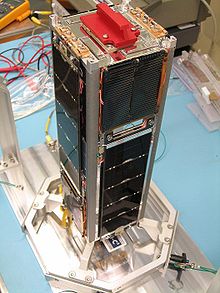- Delfi-C3
-
Delfi-C3 Operator Delft University of Technology Bus CubeSat 3U[1] Mission type Technology development Launch date 28 April 2008 Carrier rocket PSLV-CA (C-9) Launch site SLP, Satish Dhawan Space Centre COSPAR ID 2008-021G Homepage Delfi-C3 - Home Mass 2.2 kg Power 2.5 watts Batteries none Orbital elements Regime Low Earth orbit Delfi-C3 is a CubeSat satellite constructed by students at the Delft University of Technology in the Netherlands. It is a 3-unit CubeSat,[1] and was launched at 03:53:42 on 28 April 2008,[2] as part of the NLS-4 mission,[3] aboard a PSLV rocket, from the Second Launch Pad at the Satish Dhawan Space Centre in India. The launch was contracted by ISRO, through Antrix Corporation and UTIAS.[3]
The satellite's primary mission is technology demonstration and development.[4] It is carrying new types of solar cells,[4] a solar sensor for TNO Science and Industry,[4] and a high-efficiency transceiver experiment.[4]
Delfi-C3 does not contain batteries, as the experiments are dependent on the sun. She is the fourth Dutch Satellite, after ANS, IRAS and SLOSHSAT. It is the first Dutch university Satellite and is based on a 3-Unit CubeSat.
Some other mission characteristics include:
- No active attitude control
- 1200Bd BPSK VHF downlink
- Linear transponder
The Delfi-C3 ground segment consists of two command ground station, the primary being in Delft and the backup station at the TU Eindhoven in Eindhoven. For data collection, A distributed ground station network (DGSN) is used in which radio amateurs receive packets and sent these via internet to the central data collection server. Data decoding is possible with the free RASCAL software provided by the Delfi-C3 team.
See also
References
← 2007 · Orbital launches in 2008 · 2009 → Thuraya 3 | TecSAR | Ekspress AM-33 | Progress M-63 | STS-122 (Columbus) | Thor 5 | Kizuna | Jules Verne | STS-123 (Kibō ELM-PS · Dextre · Spacelab MD002) | USA-200 | AMC-14 | USA-201 | DirecTV-11 | SAR-Lupe 4 | Soyuz TMA-12 | ICO G1 | C/NOFS | Vinasat-1 · Star One C2 | Tianlian I-01 | GIOVE-B | Cartosat-2A · TWSAT · CanX-2 · CUTE-1.7+APD II · Delfi-C3 · AAUSAT-II · Compass-1 · SEEDS-2 · CanX-6 · Rubin-8 | Amos-3 | Progress M-64 | Galaxy 18 | Kosmos 2437 · Kosmos 2438 · Kosmos 2439 · Yubileiny | Feng Yun 3A | STS-124 (Kibō PM) | Chinasat-9 | Fermi | Skynet 5C · Turksat 3A | Orbcomm FM29 · Orbcomm FM37 · Orbcomm FM38 · Orbcomm FM39 · Orbcomm FM40 · Orbcomm FM41 | Jason-2 | Kosmos 2440 | Badr-6 · ProtoStar 1 | EchoStar XI | SAR-Lupe 5 | Kosmos 2441 | Trailblazer · NanoSail-D · PRESat · Explorers | Superbird-C2 · AMC-21 | Omid | Inmarsat-4 F3 | Tachys · Mati · Choma · Choros · Trochia | Huan Jing 1A · Huan Jing 1B | GeoEye-1 | Progress M-65 | Nimiq-4 | Galaxy 19 | Kosmos 2442 · Kosmos 2243 · Kosmos 2444 | Shenzhou 7 (Ban Xing) | RatSat | THEOS | Soyuz TMA-13 | IBEX | Chandrayaan-1 (MIP) | Shijian 6E · Shijian 6F | COSMO-3 | Venesat-1 | Chuang Xin 1B · Shiyan Weixing 3 | Astra 1M | Kosmos 2445 | STS-126 (Leonardo MPLM · PSSC-1) | Progress M-01M | Yaogan 4 | Kosmos 2446 | Yaogan 5 | Hot Bird 9 · Eutelsat W2M | Feng Yun 2E | Kosmos 2447 · Kosmos 2448 · Kosmos 2449Payloads are separated by bullets ( · ), launches by pipes ( | ). Manned flights are indicated in bold text. Uncatalogued launch failures are listed in italics. Payloads deployed from other spacecraft are denoted in brackets. Categories:- Student satellites
- 2008 in spaceflight
- CubeSats
- Spacecraft stubs
Wikimedia Foundation. 2010.

